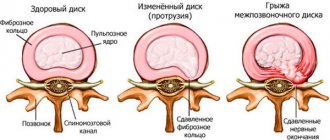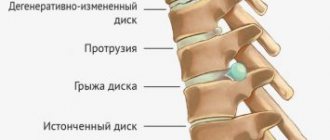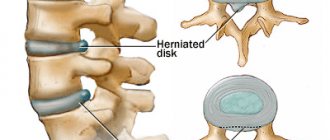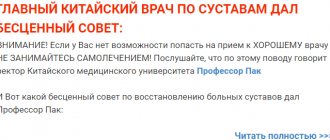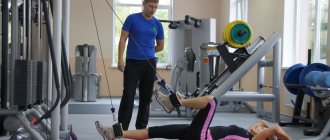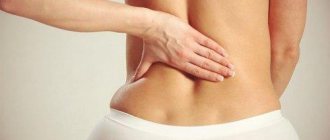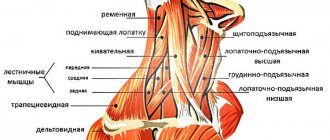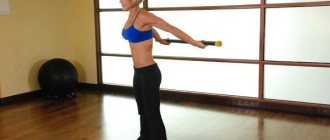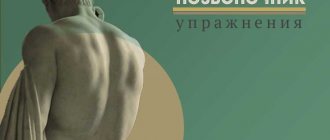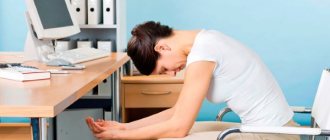From this article you will learn:
- What are the benefits of exercise therapy for the lumbar region?
- The effectiveness of exercise therapy for the lumbar region and the main contraindications
- 10 principles of exercise therapy for the lumbar region
- Features of exercise therapy for osteochondrosis of the lumbar spine
- What you need to know about exercise therapy for the lumbar region
- How to prepare for lumbar exercise therapy
- Effective exercise therapy for the lumbar region depending on the stage of the disease
- Gentle physical therapy exercises for osteochondrosis of the lumbar spine
- Exercise therapy training exercises for osteochondrosis of the lumbar spine
- 5-minute exercise therapy for the lumbar region
- Exercise therapy for the lumbar region with a fitball
- Exercise therapy of the lumbar region according to the method of Bubnovsky and Evdokimenko
Exercise therapy for the lumbar region is one of the most effective methods of treatment and prevention of complications of spinal diseases.
Physical therapy exercises take into account all the features of the pathologies of this zone. But in order to defeat the disease, you need not only to ensure that they are performed correctly, but also to be aware of the existing contraindications.
What are the benefits of exercise therapy for the lumbar region?
Nowadays, almost everyone has heard about spinal osteochondrosis. According to the World Health Organization, 80% of the Russian population has pathologies of the musculoskeletal or musculoskeletal systems. This applies not only to older people, but also to the younger generation aged 29 to 49 years.
Many people feel back pain. It causes discomfort and reduces performance. After therapy, some patients never manage to return to their previous lives, because the disease becomes chronic. This significantly interferes with the return of performance to the previous level or even provokes its cessation.
Back pain is most often related to osteochondrosis. The pathology is very common and can affect anyone.
Osteochondrosis is accompanied by metabolic disorders in intervertebral cartilage and discs. As a result, the muscular and skeletal systems change. It has been proven that the spine has a significant impact on the internal organs, which means they are also subject to pathological transformations. Many doctors say that the most effective therapy for osteochondrosis is physical activity. Therefore, we advise you to pay special attention to exercise therapy for the lumbar spine.
How does osteochondrosis develop?
The spine contains from 33 to 35 vertebrae, and between them are elastic discs. Due to them, it has flexibility and elasticity. The disc has a core covered with cartilage above and below, and along its contour there is a fibrous ring.
Osteochondrosis negatively affects blood circulation and metabolism in the spine. In this regard, the discs dry out, decrease in height, and become less durable and elastic. The fibrous ring does not cope with its function of holding the spine, which leads to its protrusion. In addition, a rupture may occur, resulting in an intervertebral hernia. The consequence of these disorders can be mobility and curvature of the spinal column.
A healthy spine is a reality, but only with an active lifestyle and moderate sports activity. Considering that the age of modern technology forces us to spend most of our time sitting at a computer, do not forget about exercise therapy for the lumbar region. After all, this is the most effective method of treating spinal diseases, as well as their prevention.
Recommended articles on the topic:
- How to massage the abdomen for weight loss: different techniques for health and beauty
- Stone massage: description, benefits, methods
- MRI of three parts of the spine: when is it necessary and what are the features of the procedure
Therapeutic exercise has a positive effect on the trophism of elastic discs. As a result, joint mobility improves, the spine is saturated with blood, and its bone components are destroyed more slowly. Exercise therapy for the lumbar region helps to recover after surgery and helps strengthen the back muscles.
Physical therapy is especially recommended for the following population groups:
- Elderly people.
- For those who have previously had vertebral injuries.
- People diagnosed with flat feet and club feet.
- For those who are constantly in a non-standard position.
- People with weak muscles and ligaments.
Osteochondrosis according to the place of occurrence can be classified into osteochondrosis of the cervical, thoracic and lumbosacral spine.
List of prohibited exercises
The following weightlifting exercises are dangerous for the sacral spine:
- deadlift;
- Romanian deadlift;
- Bend over belly cravings;
- block pull behind the head;
- squats with a barbell or dumbbells;
- lunges with a barbell or dumbbells.
You should be as careful as possible when performing even those exercises that do not involve weights. It is forbidden to lift more than three kilograms if you have diseases of the sacral spine.
For exercises, it is worth assigning a role, first of all, to a therapeutic purpose. It is impossible to pump up muscles with chronic spinal diseases. When working with equipment, the pain will certainly worsen. Many young people with a hernia and osteochondrosis want to acquire beautiful muscles, but with such diagnoses, only therapeutic exercises for the lower back can be performed. Exercise machines and performing serious exercises can lead to injury and bring the matter to the operating table.
The effectiveness of exercise therapy for the lumbar region and the main contraindications
During movement, the lumbar and sacral regions of the spine receive the main load. The vertebrae of the first zone are very mobile, unlike the vertebrae of the second zone. The latter are a fixed articulation of five vertebrae. Exercise therapy for the lumbosacral region helps strengthen the muscle corset, helps muscles that are constrained by spasms, and relieves pain in them after a pinched nerve.
Gymnastics alternately relaxes and tenses the muscles, which leads to improved blood flow. After an illness, the tissue receives stress and becomes stronger. Classes involve performing various exercises to train specific muscle groups. Exercise therapy is used for hernia of the lumbar spine.
Carrying out physical therapy of the lumbar region on a regular basis contributes to:
- Relief from lower back pain.
- Training of spinal muscle tissues.
- Normalization of joint mobility and blood flow in them.
- Relaxation of spasming muscles.
- Improving blood circulation in the pelvic organs.
- Increasing immunity and general tone of the body.
Exercise therapy for the lumbar region will be effective only if the exercises are performed correctly. Let's look at the basic rules:
- If you are doing physical therapy for the first time, be sure to contact an instructor. Your goal is the right exercises, not quick results.
- In case of exacerbation of the disease, you need to adhere to a special training program and only under the supervision of a trainer.
- Warm up your muscles and ligaments thoroughly before starting exercise. Massage the sacrum, because it bears the greatest load.
- Increase the difficulty gradually. The first workout should include a warm-up and the simplest movements. Duration no more than 20 minutes.
- It is not recommended to eat 1–1.5 hours before class.
- Perform exercise therapy for the lumbar and sacral region on a regular basis. Avoid long breaks. Only in this case can the disease be overcome.
Undoubtedly, physical therapy is very useful, but not for everyone. Exercise therapy for the lumbar region has a number of contraindications:
- Any bleeding of the body, including uterine.
- The presence of malignant tumors.
- Increased body temperature.
- The period of exacerbation of any chronic disease.
- Swelling and cramps, poor circulation in the legs.
- In the presence of an inflammatory process of any organ. May be accompanied by general malaise or fever.
If, while performing exercise therapy for the lumbosacral region, you notice at least one of the symptoms listed below, consult a doctor immediately. The lesson plan may need to be adjusted:
- Sharp pain.
- Receiving microtraumas and other damage.
- Malaise and deterioration of health.
- Exacerbation of a disease associated with the spine or lumbosacral region.
Features of therapeutic exercises
Conservative treatment, as well as the rehabilitation period after surgical operations, are supplemented with sports activities. It is rational to engage in physical therapy for mild or moderate vertebral displacement, if there are no serious injuries. Gymnastics for sacral dislocation includes a set of special exercises aimed at achieving the following therapeutic effects:
- spinal column sprain;
- restoration of the normal position of the vertebrae;
- strengthening the muscle corset and ligaments;
- preventing the development of seizures and spasms;
- reducing the intensity of pain;
- restoration of the functions of the nervous and circulatory systems.
An experienced instructor should select exercises and teach you how to perform them correctly. The exercise therapy program for stabilizing the sacral region is determined based on the type of disease.
In case of true displacement of the vertebrae due to degenerative lesions of the bone segments of the spine, muscles and ligaments of the back, physical education is aimed at improving the trophism of damaged anatomical structures.
To do this, it is preferable to perform dynamic movements, avoiding forceful loads. False displacement of the sacrum occurs without pronounced symptoms, and therefore is more often detected in the later stages of the disease. The exercise therapy complex includes mainly strength exercises designed to return the vertebrae to their place and strengthen the muscles.
Displacement of the sacrum as a result of injury is treated under the guidance of a doctor. It is necessary to constantly wear an orthopedic corset, removing it during training.
With a pathological type of displacement of the sacrum, accompanied by disturbances in the functioning of the nervous system, activities with a high load on the spinal column are contraindicated. Each movement should be performed smoothly, without sudden movements. If pain increases during gymnastics, exercise should be stopped and the instructor should be informed.
Features of exercise therapy for osteochondrosis of the lumbar spine
Most often, pain is felt in the lumbar spine, since it bears the main load. This is due to the anatomy of the human body structure.
Symptoms of osteochondrosis of the lumbosacral region include pain in the legs and lower back. Their cause lies in irritation of the spinal nerve roots. Swelling forms around the irritated area of the root, increasing the pain and causing it to spread to the muscles. The affected area is affected by the resulting spasm. The process is a vicious circle. But it can be interrupted by influencing the muscle system and strengthening the muscle corset.
We recommend
Anti-wrinkle facial massage: 10 effective techniques Read more
How to do this? Exercise therapy for the lumbar region, massage and useful habits in everyday life will help you here. If pain is observed in the lower back or legs, it is necessary to perform gymnastics in a lighter form.
The objectives of exercise therapy for osteochondrosis of the lumbar spine are to:
- relax and stretch tense back muscles;
- strengthen lymph and blood circulation in the lumbar region.
Follow the principles of gymnastics described above. Clearly remember what not to do, and then exercise therapy for the lumbar region will be useful and effective.
Exercise "Frog"
This is an effective and popular exercise therapy exercise. In case of a hernia of the lumbosacral spine, it allows you to reduce the intensity of pain and slightly stretch the spinal column.
Starting position: get on all fours. Spread your knees as wide as possible and try to lower yourself onto them. Execution largely depends on the flexibility of the hip joints. If you can’t spread your legs wide, it doesn’t matter, you need to do it at the distance that is available. You need to raise and lower your pelvis - this is what doing exercises for the lower back at home is all about.
The total number of repetitions is no less than ten and no more than twenty. If an exercise provokes sharp pain in the lower back, sacrum or tailbone, you should delete it from the program.
If the mobility of the hip joints and lumbar region does not allow you to perform the exercise, you should try to perform it gradually, increasing the depth of the legs by several millimeters every day. Exercise therapy exercises for a hernia of the lumbosacral spine imply a standard level of flexibility, and it should be developed.
What you need to know about exercise therapy for the lumbar region
The basic requirements for physical therapy are as follows:
- Classes can be started only after pronounced pain has been eliminated.
- During an exacerbation of osteochondrosis, it is recommended to do only simple movements.
- Training should be carried out on a regular basis during remission of the disease.
- Increase the range of motion and number of repetitions gradually.
- Watch your breathing, it should be measured and calm.
- Movements should be smooth. If you feel pain, you should end the session.
- The first training should be carried out strictly under the supervision of an instructor.
- Before classes, contact a specialist for advice and a program.
- Wear only breathable clothing.
If you have problems with the lumbar spine during exercise therapy, it is prohibited to:
- Use maximum loads at the very beginning of your workout.
- Make movements that lead to painful sensations.
If osteochondrosis worsens, perform exercises only in bed.
During exercise therapy for hernias and protrusions of the lumbar and sacral regions, it is contraindicated to lift weights while standing, do leg presses while lying down, jump and run.
Basic principles of performing therapeutic exercises
Exercises for the sacral spine should be performed adhering to the following rules:
- All movements are smooth and easy; jerking, jumping, and sudden lunges are prohibited.
- Stretching should be done as slowly as possible and not cause pain.
- If you are thirsty, you should not limit yourself to drinking clean water during training.
- The optimal time to eat is two hours before exercise and about three hours after.
- Before starting exercises for the sacral spine, you should do a warm-up, and then a cool-down.
- Monitor your breathing and do not hold air in your lungs, try to inhale diaphragmatically and exhale through the chest.
How to prepare for lumbar exercise therapy
Physical therapy may be prescribed by a doctor after the results of the examination. Don't forget about the rules that will help you make it effective:
- The best time for classes is before lunch. The last meal should take place 1.5 hours before they start.
- Every workout should start with a warm-up. It helps warm up muscles and ligaments, prepares the heart for stress.
- During the exercise, use a roller under your knees at the correct height (the thigh and shin are perpendicular to each other).
- Record the exercises you perform in your diary and monitor the results.
For osteochondrosis, there is a whole complex of gymnastics. Exercises vary in difficulty and stages. Follow the lesson plan without combining them with each other.
The lumbar exercise therapy program is divided into blocks that are intended for a specific stage.
The first stage is carrying out exercise therapy in the acute period . As simple and slow movements as possible.
The second stage is the subacute period . If the pain has decreased, you can increase the load, but gradually.
The third stage is remission . The pain has stopped, complex exercises are included.
Choose loose clothing that will not interfere with your workout. We recommend paying attention to a cotton T-shirt or tank top, shorts or sweatpants. If you exercise outside in cold weather, use woolen items.
Inventory you will need:
- Gymnastic ball.
- Swedish wall.
- Pillow for the knees.
- Fitness mat.
Indications and contraindications for performing exercises on the lower back
Gymnastics for the sacrum and lower back can be useful even for those who are not bothered by pain. Typically, exercise is prescribed to people who have the following symptoms:
- mild to moderate pain that occurs after exercise and is not associated with previous injuries;
- postoperative recovery period;
- condition after an injury to the lower back.
The main factors limiting exercise therapy for pain in the sacrum:
- early recovery period after surgeries and back injuries;
- advanced glaucoma;
- high blood pressure;
- chronic heart failure in the stage of decompensation;
- tumor diseases;
- pregnancy;
- severe exacerbation of back pain, an attack of radiculitis;
- problems with the vestibular system: inner ear injuries, Meniere's disease, etc.;
- tendency to arrhythmias;
- elevated body temperature at the time of exercise;
- extensive skin lesions with ulcers, as well as fungal and bacterial lesions.
In case of sacral dysplasia and chronic diseases, gymnastic exercises can only be performed after an individual consultation.
Effective exercise therapy for the lumbar region depending on the stage of the disease
1. Acute period.
Exercise therapy for exacerbation of osteochondrosis of the lumbar spine should be carried out only under the supervision of a trainer. Make slow movements. If pain occurs, training should be stopped. The exercises are performed from a lying position.
- It is necessary to develop the feet by performing movements of flexion and extension. First together, then after each other. Increase the pace whenever possible. Clench your fingers into a fist and then unclench them.
- I. p. – bend your legs at the knee joint. Extend one leg, your heel should slide across the bed. Repeat for the other leg. Do eight reps.
- Raise your hand up. Once you lower it, repeat for the other hand.
- Bend your left leg and move your right leg to the side. Repeat, switching the position of your legs with each other. The exercise loads the lumbar region. Avoid sudden movements. They can put increased pressure on nerve cells and aggravate osteochondrosis.
- I. p. – put your hands on your shoulders. Move in a circle. First clockwise and then counterclockwise.
- Rest your thighs on the bolster. Straighten your legs at the knee joint one at a time.
- As you exhale, bend your arms, trying to touch your shoulders. As you inhale, straighten, touching your thighs with your fingertips.
- I. p. – bend your legs at the knee joint. Move one knee to the side and return to the starting position. Repeat the same with the other one.
- Stretch your arms up. At the same time, pull your socks towards you. After lowering your arms, relax.
- I. p. – bend your legs at the knee joint. Spread and bring your knees together. You can diversify the movements by moving your knees first to one side, then to the other.
- Try to pull your bent knees one after the other towards your stomach. Help with your hands when doing this.
We recommend
Therapeutic massage for the back: features, indications and contraindications More details
2. Subacute period.
If there is an improvement in the course of the disease, the pain has subsided, you can diversify exercise therapy for the lumbar spine with more dynamic movements.
- I. p. – bend your legs at the knee joint. Straighten your right one up. Repeat for the left, four times on each. Do not straighten your leg completely if you experience pain.
- Lean on the bed with your arms bent. Try to arch your chest as much as possible. After completing the exercise, relax.
- In a lying position, you need to bend your legs and raise your back area in the sacrum area. Try to lean on your lower spine.
- Tighten and relax your buttocks.
- Bend your legs one after the other. While straightening them, press down on the bed with your foot and try to arch your lower back a little.
- Lie down and bend your legs. Raise your head while contracting your abdominals and buttocks. If the exercise is easy, try raising your pelvis a little.
3. Remission.
Exercise therapy for osteochondrosis of the lumbar spine in remission can be supplemented with complex movements. At the same time, the load increases, which means you need to carefully monitor your condition even without pain. Physical overexertion is dangerous and can lead to a sudden exacerbation of the pathology.
- I. p. - lying on the side. Pull one thigh toward your stomach first, then the other. Try to do the exercise all the way, thereby stretching the lower back muscles as much as possible. Perform five to seven repetitions on each leg.
- I. p. - on all fours. Imagine an obstacle and carefully crawl under it.
- I. p. - sitting on a hard surface, hands on knees. The back is straight. Slowly lean back, tensing your abdominal muscles. Stay a while. Return to the starting position at the same pace.
- I. p. - on all fours. Arch your back while lowering your head. Make reverse movements: arch your back, raising your head up.
- Stand up straight. Bend forward, trying to reach your toes with your hands. The chest should be pressed against the hips as much as possible. The exercise is also effective from a sitting position.
- I. p. - on all fours. Raise your legs bent at the knee joint and bend your lower back slightly. Movements help relieve symptoms of osteochondrosis.
- The legs are bent at the knee joint. Sit on them, and your heels should be level with your buttocks. Reach up and interlock your fingers. Sit on the floor, changing direction: first left, then right.
- I. p. - on all fours. Raise your arm and opposite leg. Stay in this position for a while. After returning to the starting position, repeat with the other limbs. Do five times for each side.
When is spinal traction used?
Hip bridge
- Lying on your back, arms relaxed, lying along the body, legs bent at the knees, slightly apart, feet parallel.
- Without lifting your heels from the floor, raise your pelvis and back. The back and buttocks should be in the same plane. Fix for 10-30 seconds.
- The back and hip part are involved. Well corrects problem areas in women with sedentary, sedentary work.
It is performed in two versions, depending on the pain in the back:
- Lying on your back, stretch your legs. Raise your straightened legs and hold them at an angle of 45-50 degrees for as long as possible.
- Lie on your back, place your legs so that your legs are higher than your head, for example on a chair or other object.
Perfectly strengthens the lower back and removes extra grams from the stomach.
"The Dog and the Bird"
- Standing on all fours, place your palms on the floor. The knees are slightly apart.
- Drawing in the stomach and bending the back, move the leg bent at the knee as far forward as possible, at the same time, touch the knee with the elbow on the opposite side, and then, with a deflection, stretch the leg back and the arm forward. Stay in this position for a few seconds. Repeat the movement for the other leg.
- Balanced load on the spine, strengthens the muscles throughout the back and the back of the upper thighs.
Hip stretch
- Lie on your back, lift and bend your leg at the knee, then place the other ankle under the knee bend of the first, and with your hands pull them in this position to your chest. Repeat, changing the position of the legs.
- Promotes realignment of vertebrae during microdislocations.
Side plank
- A static stand on an arm bent at the elbow is performed in such a way that it forms a right angle to the rest of the elongated body lying on its side.
- Relying only on the bent arm and the outer part of the foot. The legs are closed, lying one on top of the other. Stay motionless in this position for thirty seconds to one minute, then perform on the other side (side).
- Before and after static exercises, there must be breathing exercises. This is due to the load on the heart, without the ventilation of the lungs in the form of rapid breathing inherent in dynamic exercises.
- Failure to follow these simple rules leads to increased wear and tear of the heart muscles, or as athletes say: “you can damage your heart.”
Hyperextension
- Identical to the previous one, it is performed on a simulator or using two pipes parallel to the ground of different heights, in a more complex version on uneven bars; in their absence, it can be performed from a position lying on the stomach, hands behind the head.
- Extension is the bending of the torso due to the work of the back muscles.
Lunges
- Starting stance: feet shoulder-width apart, arms bent at the elbows, hands on the sides.
- Exercise: take a maximum step forward with your right foot forward, after which the center of gravity is smoothly transferred between the legs, and then to the bent leg extended forward.
- The right leg rests on the entire area of the foot, the left leg rests on the toe, and the knee touches the floor.
- Correct execution of the exercise gives a good load on the hips and warms up the lower back.
- Lying on the ball with your lower abdomen, legs straight, hands behind your head, torso bent, forehead touching the floor. Due to the work of the back muscles, lift your head off the floor and straighten your body, returning to the starting position.
- Hyperextension is the best for pumping the entire back, with any variations.
- Starting position: lying on your back, legs bent at the knees, feet parallel to each other, heels moved as close as possible to the pelvis, hands clasped behind the head.
- Legs bent at the knees, without lifting the feet from the floor, with twisting of the lumbar spine, lowered as far as possible to the side, towards the floor.
- At the same time, the upper part of the body, with twisting of the spine, turns in the opposite direction. The exercise is performed slowly, with fixation for 5-10 seconds at the points of maximum twisting.
- Any twisting of the spine is strictly prohibited for people with an intervertebral hernia.
Pelvic lift
- Similar to the very first one in the description, it is performed dynamically, with multiple repetitions, each person selects the quantity individually, if physical fitness allows, weights are used (a barbell weight plate).
- Strengthens the entire lumbar region.
Baby pose
- Lying on your back, bend your legs and pull them towards your stomach, wrap your arms around them and press them to your chest. Stay in this position for thirty seconds to a minute.
- The baby's position, or the fetal position, is the most natural for humans, since the formation of the skeleton in the mother's womb occurs in it. It provides not only maximum protection of internal organs from external influences, but also stimulates the return of the vertebrae to their “original state.”
- When used on a simulator, it is performed both statically and dynamically.
- From an inclined position, with your legs fixed, straighten your back and return to the starting position.
- Designed to pump the entire back.
- Lying on the ball with your stomach, relax all your muscles. Stay in this position for as long as possible.
- Lying with your back on the ball, bend over, relax all your muscles, and stay in this position for several minutes, depending on how you feel. This stretch is extremely beneficial for your back.
- An ideal warm-up and ending to classes, a good alternative to hanging on the bar, one of the few movements for decompressing intervertebral discs.
Deadlift
- Performed with a barbell (weight), both dynamically and statically.
- Place your feet slightly wider than your shoulders, slightly bend your knees, grab the bar of the barbell with a comfortable grip, and while unbending, lift the barbell off the floor, solely due to the work of your back muscles.
- The most effective strengthening of the lower back, however, if the technique is not followed, sciatica is guaranteed.
There are times when a hood is simply necessary, but there are also situations when it will be unnecessary and it is advisable to abandon it. Based on this condition, it is impossible to give an unambiguous answer to the question posed.
- Traction is performed to eliminate displacements resulting from dislocations and fractures. However, traction is always accompanied by fixation of the vertebrae in a certain position after traction;
- If a person has scoliosis, then prolonged traction is extremely dangerous, as this can cause injury and lead to other undesirable complications. Scoliosis needs to be dealt with comprehensively. That is, in addition to traction, the patient needs to be prescribed special massage and gymnastics, as well as corrective collars and corsets.
- But in case of osteochondrosis, it is generally not recommended to engage in traction, citing the fact that any minimal mechanical impact on the injured spine is extremely dangerous, because it can damage already problematic vertebrae and discs;
- If you have a herniated disc, then by prescribing traction, you are not sent for a complex operation and are given the opportunity to be cured without surgery. Definitely, for any pathologies of various parts of the spine, each vertebra has its own limit of permissible traction force. If it is exceeded, serious injury may occur.
We suggest you read: Injections for osteochondrosis of the lumbar spine
Any physical exercise has its contraindications, and traction is no exception. It is highly recommended not to ignore the recommendations below, because otherwise, you can aggravate existing diseases with several new diseases.
- It is forbidden to stretch in case of osteochondrosis, osteoporosis and arthritis;
- Traction is not advisable if you have vascular disease, heart disease or hypertension;
- In case of thrombosis, stretching is strictly prohibited!
- Modern medicine is extremely cautious about performing traction during menstruation and pregnancy. First, consult your doctor and listen to your feelings;
- Spinal stretching is highly undesirable for colds and viral diseases accompanied by fever;
- Follow the rules of physical therapy - do not overexert yourself and do exercises with force. If you feel weak in your body, stop using the hood.
To stretch your sore back, you can safely use proven yoga exercises. If you have had experience doing yoga, then the following set of exercises for stretching the spine will be very helpful:
- When stretching your thoracic back, take a standing position and place your feet slightly wider than your shoulders. Slowly lower your head and bend at the thoracic back. But watch your lower back, it should not bend at this time. Then stretch up and relax your muscles. You need to stay in this position for 10 seconds.
- Bend forward. The starting position is the same as the case described above. Next, bend forward and touch the floor with your palms. The muscles of the legs and back should be relaxed so that the entire load falls on the spine.
- The next type of bending is performed from the starting position described above, only now you need to touch your legs with your forehead and clasp your shins with your hands. Naturally, without preliminary training, you are unlikely to be able to perform this exercise efficiently and the first time. But gradually you will achieve the necessary flexibility and you will complete the exercise without any difficulties.
- Regular bends that are performed from a standing position. Place one leg forward and, while bending, touch your forehead to your exposed leg. Stay in this position for half a minute and breathe evenly and calmly.
- Hands locked behind your back. The exercise must be performed standing or sitting, and the hands are placed behind the back, one of which is placed from below, and the second from above from behind the head. Now try to clasp your hands.
- Flexibility exercise from school. Sit on the floor and stretch your legs. Next, bend forward and grab your feet with your palms. Touch your forehead to your knees and stay in this position for 15-20 seconds.
- Hanging on a wall bars or horizontal bar is also an excellent way to stretch the spine.
Below are effective exercises for stretching the spine at home for various back diseases.
When turning to therapeutic exercises for various problems and diseases of the lumbar and lumbosacral spine, it is important to understand the need for discussion with a specialist. Only professional medical participation will allow you to achieve maximum results taking into account the current factors, as well as avoid possible negative manifestations and unwanted side effects, such as:
- general deterioration in well-being due to incorrectly calculated load and incorrectly selected exercises;
- aggravation of existing diseases, especially chronic ones, for example, scoliosis to any degree, pathologies of the genitourinary system, which are most closely related to the lumbar and sacral vertebrae by direct innervation;
- inflammatory processes in any part of the body, as evidenced by increased body temperature, pain, weakness;
- poor circulation in the lower extremities, which is expressed by the effect of cold legs, weakness in them, swelling and even cramps;
- microtraumas and more serious injuries that are possible in old age due to an incorrect set of exercises or excessive enthusiasm of the patient.
Old age during exercise therapy is a factor that requires special attention from a specialist
Gentle physical therapy exercises for osteochondrosis of the lumbar spine
1. Lying on your back.
- Hands at your sides, legs together. As you inhale, pull your arms up, and as you exhale, lower them. Number of repetitions – 4-5.
- Bend and straighten your feet while clenching and unclenching your fists. Do it 10 times.
- Rotate your feet in a circle. In each direction 4-6 times.
- Pull your knees to your chest one at a time. Do 6-8 reps.
- Move your right arm and leg to the side, for example. Repeat in the same way for the left limbs. Do 4-6 repetitions.
- Clasp your fingers in a “lock” at the back of your head. Raise your head while pulling your toes towards you. Number of repetitions – 8.
- Hands at your sides. As you inhale, stretch your arms up, while simultaneously pulling your toes in the opposite direction from you.
- Place your legs bent at the knee joint, shoulder-width apart. Use your knee to touch the opposite foot, and vice versa. Do 4-6 times.
- Exercise “bicycle”, simulating pedaling. Repeat five circles back and forth.
- Place your hand on your stomach. Take a deep breath into your belly and then exhale slowly. Number of repetitions – 3-4.
- Stretch your left hand along your body, and stretch your right hand up. Repeat the exercise, changing the position of your hands. Do 10–12 times.
- Spread your arms to the sides, feet shoulder-width apart. With your left hand, reach your right hand. Repeat the exercise for opposite limbs. Number of repetitions – 6–10.
- Pull your knees towards your chest with your hands. First the left knee, then return to the starting position and repeat the exercise with the right. Do 6-8 times.
2. Exercise therapy lying on your side.
- Swing your arm and leg upward. Repeat about five times.
- Pull your knees to your chest: 6-8 reps.
- Swing your leg forward and backward. Repeat 6-8 times.
Perform the exercises in the same way, lying on the other side.
3. Exercises while standing on all fours.
- First move one hand to the side, then the other. Do 10–12 reps.
- Swing your leg back, straightening it. Repeat with the other leg. The quantity for each is 8–10.
- Pull your left knee towards your right hand. Repeat, switching sides of limbs. Do 6-8 times.
- Pull one knee toward your chest. After this, take your leg back, the toe should slide along the floor. At the same time as this movement, you need to sit on the opposite heel. Perform the exercise in the same way with the other leg.
- Swing your straight leg up and back. At the same time, pull your opposite hand up. Repeat similarly for the other leg and arm. Do 6-8 times.
- The legs are fixed in one position, and move your hands to the right and left sides. Repeat five times in each direction.
- Without lifting your hands from the floor, try to sit on your heels. The exercise is performed slowly. Do 6-8 times.
- Without lifting your hands from the floor, sit first on your left buttock and then on your right. Repeat 6-8 times.
- Place your hands on the floor and raise your head. Arms straight. Lower your head to your chest and arch your back, then arch it back. Make movements at a slow pace. Number of repetitions – 8–10.
Third period of exercise therapy
At this stage, the goal of exercise therapy for a pelvic fracture is to strengthen the muscles of the lower extremities, restore walking and overcome possible lameness. The exercises are performed mainly in a standing position. It is necessary to train the strength and endurance of the muscles of the foot, lower leg, buttocks, and thighs.
It is important to establish a correct gait and prevent uneven steps. Otherwise, it may cause lameness in the future. It is useful to take high steps in one place, holding onto the back of a chair or bed. Then, supporting the patient by the hands, you need to gradually teach him to walk without limping.
Exercise therapy training exercises for osteochondrosis of the lumbar spine
For exercise therapy of the lumbar region, training exercises are indicated while the pain subsides. During the acute stage they are prohibited.
Tasks:
- Completely form the muscle corset.
- Normalize the range of motion in the leg joints.
- Repeat the number of exercises that include movements in the lumbar region strictly in accordance with the training plan.
1. Lying on your back.
- Bend your legs at the hip and knee joints. The shins should rest on the support. Join your fingers behind your head into a “lock.” Lift your head and shoulders off the floor. Do 6-8 times.
- The shins rest on the support. Hold the ball between your feet. Move it to the left, then to the right. Do 6-8 reps.
- Hold the heavy ball with your feet. The shins rest on the support. Your task is to pull your knees towards your chin, lifting your head off the floor. Perform 6–8 times.
- Bend your legs at the hip joint. The shins should rest on the support. Take dumbbells in your hands and stretch them along your body. Try to sit down. Do 6-8 times.
- Take dumbbells in your hands and move them to the right. At the same time, tilt your knees to the left. Repeat 6-8 times.
- Bend your knees and hold the ball between your feet. Take dumbbells. Try to sit down and hold this position. Do 6-8 reps.
2. Lying on your stomach.
- Stretch your hands in front of you. Raise your head and shoulders at the same time. Move your right arm behind your back, accompanying this movement by turning your torso to the right. Repeat the same with your left hand.
- Place your arms straight behind your back. At the same time, lift your head, shoulders and upper body off the floor. Raise your legs with your knees bent. Repeat 6-8 times.
- The legs need to be bent and then straightened at the knee joint in turn. Only 15–20 times.
Don't forget to take your heart rate before and after your workout. Its optimal value is 120–140 beats per minute. Exceeding the normal heart rate indicates that the load is high for you.
Second period of exercise therapy
How much exercise therapy should you do after a pelvic fracture in the second period? This stage of treatment lasts about 2–2.5 weeks. It is allowed to perform more complex and intense exercises. In this case, both lower limbs should be involved, and the hips should not rest on the roller. You can bend your knees, lift and hold each leg straight.
Typically, 2.5 weeks after injury, patients are allowed to roll over. From now on, exercises for a pelvic fracture can be done not only on the back, but also on the stomach.
If the patient tolerates gymnastics well and does not experience pain during exercise, then after 3–3.5 weeks he is allowed to get up and walk. After this, third period classes begin.
5-minute exercise therapy for the lumbar region
- Lying on your stomach, legs straight, bend your arms at the elbows and press them to your body. Lean on your straight arms and lift your upper body off the floor. Turn your head first in one direction, then in the other. Return to the starting position and relax. Do 2-3 repetitions.
- Lying on your stomach, stretch your arms forward. Legs remain straight. Raise your torso while simultaneously performing a crawl motion with your arms. Repeat 4-6 times.
- Similar to the previous exercise, move your arms using the breaststroke technique. Do 4-6 reps on each arm.
- I. p. - lying on your stomach, hands pressed to your chin. Crawl on your bellies. The movement involves pulling the knee towards the elbow. Repeat 4-6 times.
- The situation is similar to that described above. Lift one of your straight legs up, point your toes down. Repeat the exercise with the other leg. Do 4-6 times.
- Raise your arms and legs at the same time. Hold this position and after a few seconds return to the starting position. Relax. Do 3-4 repetitions.
First period of exercise therapy
This stage lasts from 10 to 14 days. Patients can do breathing exercises and active movements of the upper body and arms. The legs should remain on the bolsters. Special exercises for fractures of the pelvic bones include raising the hips (for using a bedpan). At first, this movement is performed under the supervision of an instructor, but from 4–6 days of illness the patient can do it independently.
On days 5–7, the patient can bend his leg at the knee. The thigh should lie on the cushion. If skeletal traction is used, the patient can make more active movements of the leg on the healthy side.
Exercise therapy for a pelvic fracture during this period can be combined with massage. This will help reduce swelling and prevent blood clots. Massage procedures can be started from 3-4 days, if there are no contraindications.
Before starting exercises, the room must be well ventilated. The head should be in a slightly elevated position. After 10–14 days, you can move on to the next stage of treatment.
Exercise therapy for the lumbar region with a fitball
- "Locust". Lie on the fitball with your stomach and take turns lifting your arms and legs.
- Hyperextension. The stomach and thighs lie on the ball. Hands behind your head, legs extended back. As you inhale, bend forward, and as you exhale, return to your starting position. The exercise affects the back, do it smoothly.
- Half bridge. I. p. – lying on the floor on your back, put your feet on the fitball at an angle of 90 degrees. As you exhale, you need to straighten your legs and raise your pelvis. While inhaling, take the starting position.
- I. p. similar to the previous paragraph. Grab the ball with your feet, clasp your hands behind your head. Pick up the exercise ball.
- Twist/"flugel". Back on the floor, feet on a fitball. Hands are spread to the sides. Roll the ball with your legs in different directions. Your goal is to touch your knees to the floor.
Effective exercise therapy for the lumbar region involves repeating these exercises about 20 times.
Exercise "Birch"
It came to us from hatha yoga. “Beryozka” is familiar to everyone from school. When performed correctly, it promotes blood flow from the lower body. This relieves pain in diseases of the lumbosacral spine. You can remain in the position of the static exercise “Birch” for up to one minute. If your level of physical fitness is low, you can limit yourself to five seconds.
The starting position of the exercise is lying on your back. The shoulder blades, head, and lower back are pressed to the surface. It is necessary to lift your straight legs off the floor, and without bending them at the knees, lift them above your head, then lift your lower back off the floor and stretch out straight in a “string”, holding your body on your shoulder blades, you can support yourself with your hands and lean on your elbows. The more vertical the body is, the better. You should stay in this position for at least five seconds, but no more than one minute.
Exercise therapy of the lumbar region according to the method of Bubnovsky and Evdokimenko
Sergey Bubnovsky is a rehabilitation specialist by profession, the author of a large number of exercise therapy complexes for joints, recognized by official medicine.
Pavel Evdokimenko is a rheumatologist, a member of the highest level of the Academy of Medical Sciences of the Russian Federation. Among his works are a huge number of books that describe recommendations for the treatment of arthritis and arthrosis.
Doctors Bubnovsky and Evdokimenko developed an effective set of exercises. You can familiarize yourself with the technique of their implementation, which will make physical therapy of the lumbar spine more effective, in the video.
- Lying on your stomach, reach your buttocks with your heel, bending your legs one at a time. The head is turned in the opposite direction. Hold the position for 10 seconds. After this, relax for a few seconds and repeat the movement again.
- I. p. - on all fours. Arch your back and hold this for five seconds. After that, relax. Performing the exercise from the side resembles the behavior of a cat on its hind legs, which is why it has a similar name.
- I. p. - lying on your back. First pull one leg towards your stomach, then the other. Help with your hands. Tighten your muscles for seven seconds and then relax.
- I. p. - lying on your back. Wrap your arms around your legs and pull them towards your stomach. Tighten the muscle tissue for 10 seconds, then relax.
- I. p. - sitting on a chair. Bend over slowly. Your task is to thoroughly stretch your back. As you inhale, tighten your lower back muscles for six to seven seconds, and as you exhale, relax.
Video instructions for exercise therapy of the lumbar spine:
.
Nowadays, you no longer have to spend a lot of time performing complex and unpleasant procedures at home. It is much easier to seek help from real professionals - the Veronika Herba beauty and health center, equipped with effective and modern equipment.
Why clients choose Veronika Herba beauty and health center:
- This is a beauty center where you can take a course of exercise therapy for the lumbar region at a reasonable cost, and you will be treated not by an ordinary cosmetologist, but by one of the best specialists in Moscow. This is a completely different, higher level of service!
- You can receive qualified help at any time convenient for you. The beauty center is open from 9:00 to 21:00, seven days a week. The main thing is to agree with your doctor in advance on the date and time of your appointment.
Sign up for a consultation with a specialist by calling 8 (495) 995-15-13, and you will see for yourself!
Walking with pelvic fractures
To form a correct gait, you need to avoid dragging your feet and shifting from one limb to another. A useful exercise in the third period is walking in water.
Walking without crutches is allowed approximately 3 months after the injury. To develop your legs, you need to walk daily. Their duration must be increased gradually. Special exercise machines called steppers will also help restore correct gait.
The rehabilitation process after a pelvic fracture occurs in different ways. Many patients manage to completely restore motor function. When the symphysis pubis is damaged, most people remain disabled. It is not uncommon for patients to suffer from intermittent pain for 1–2 years after injury. As for professional athletes, they usually do not return to training and competition after suffering an injury.
Dosed loads on the back have a positive effect on reducing pain. However, before performing exercises for the sacrum at home, you need to understand how to conduct exercises correctly so as not to worsen your condition.
Traditional treatment of sciatica
Traditionally, sciatica is treated conservatively. The patient is prescribed:
- anti-inflammatory drugs (Diclofenac, Ortofen, Ibuprofen);
- painkillers (Ketonal, Movalis);
- novocaine blockades;
- muscle relaxants (“Mydocalm”, “Sirdalud”);
- warming ointments based on bee or snake venom;
- B vitamins.
Severe damage to the intervertebral discs may require surgical treatment..
In addition to drug and surgical treatment for radiculitis, physiotherapeutic procedures are prescribed to relieve the inflammatory process, as well as to accelerate tissue regeneration and have a warming effect. Manual therapy and visits to a massage room and exercise therapy room are also recommended.
Video: “Exercises for acute back pain”
Find out more about traditional treatments for sciatica:
- You can find the names of gels and ointments for radiculitis on the page
- Effective injections for radiculitis, 3 ampoules each
- What medications are the most effective for radiculitis can be found out by going to the next article
Lesson plan, general rules
performed at the first stage of the acute period (for severe pain);
performed at the second stage of the acute period (with the easing of pain);
performed during the period of remission (pain sensations are minimal or even absent).
It is important to strictly adhere to the lesson plan and not mix exercises from different blocks.
You can do physical therapy at any time of the day, the main thing is that an hour or more passes after eating.
When performing the complex, movements should not cause pain. Otherwise, this is a signal to abandon a particular exercise or reduce its amplitude.
To achieve the maximum effect from therapeutic exercises for lumbar osteochondrosis, you must:
- exercise daily;
- perform exercises at a slow pace, concentrating on the work of the muscles;
- remember to breathe correctly;
- Tell your doctor about all results and any questions that arise.
Treatment of unstable sacral fractures - indications for surgery and types of interventions
Surgical manipulations for this type of injury are practiced in extremely rare cases: with severe displacements of bone structures, as well as in the case of rupture of neurovascular bundles.
- The main method of surgical treatment of unstable sacral fractures is osteosynthesis . The fragments are fixed using special metal structures: plates in the shape of the letter L, coarse screws, etc. Such an operation requires certain preparation on the part of the patient: laboratory tests, X-rays and/or CT, ECG. General anesthesia is often used, although in some cases spinal anesthesia may be used. The patient can be placed on his back, stomach or side - it all depends on the location of the injury, as well as on the scenario of surgical manipulations. After connecting the bone fragments, the operator sutured the tissue layer by layer and installed drainage tubes. Sutures are usually removed after 10-14 days, after which the patient is sent home, and observation is carried out on an outpatient basis. Bed rest should be adhered to for a month, after which it is necessary to undergo a rehabilitation course.
- If there is regular intense pain, a laminectomy . Through surgery, the doctor eliminates a fragment of bone tissue that puts pressure on the nerve roots. This procedure improves blood circulation in the injured area and helps eliminate pain.
- One of the modern methods of treating sacral fractures is sacroplasty . This procedure is considered minimally invasive and is performed using a local anesthetic. The essence of the technique under consideration is the introduction of bone cement into the area of bone injury in order to restore - or strengthen - bone tissue. Such treatment speeds up the healing process, but it cannot be carried out if the walls of the sacral canal are destroyed. Although this manipulation is considered safe, certain negative consequences cannot be ruled out, the most dangerous of which is blockage of the lumen of the pulmonary artery or cerebral vessels with a thrombus.
Possible negative consequences
In the first days of performing a set of exercises for the sacrum, you will feel discomfort. In rare cases, unpleasant consequences of exercise are possible. It is necessary to stop gymnastics for pain in the sacrum if:
- after exercise, the pain in the lower back intensifies or appears in another place;
- a crunching or clicking sensation is felt during exercise therapy for a sacral fracture;
- after exercise, blood pressure increases, dizziness and weakness appear;
- The sensitivity of the skin in the lower abdomen, lower back, thighs has changed, and a feeling of goosebumps has appeared.
Less than 1% of patients experience an exacerbation of radiculitis or osteochondrosis after practicing therapeutic exercises, which requires professional help. Moderation in independent exercise and careful adherence to the technique of performing exercises to strengthen the muscles of the sacrum will help to avoid complications.
This type of fracture is considered a serious injury. With untimely and inadequate medical care, complications can develop that significantly worsen the patient’s quality of life and can also cause disability.
The treatment tactics for a sacral fracture will be determined by its type, but in all cases the principle of an integrated approach applies: strict bed rest is combined with drug therapy, physiotherapy, and diet. In particularly difficult situations, surgical intervention is resorted to.
Massage through the rectum
During massage of the tailbone through the rectum, the patient lies on his left side. The legs are pulled towards the stomach. The doctor injects novocaine into the area near the tailbone. This process is controlled by the index finger, which is inserted into the rectum. Then the finger continues to be inserted even deeper.
Movements begin forward and upward. Then the fingertip moves from the symphysis to the coccyx muscle. The massage is done for 2 m. All movements should be soft, without causing pain.
During the massage, the patient should strain a little. In this case, the muscles can be clearly felt. They relax after each session and pain gradually disappears. Improvement begins to be felt after 3-4 sessions. After the seventh procedure, massage is done 1-2 times a week.
If proctological diseases are detected, which are reflected on the tailbone in the form of painful sensations, a surgical operation is performed. This is followed by a massage of the deep pelvic muscles.
Read also…. Dorsalgia: symptoms and treatment of this type of pain in the spine
Who should not do exercise therapy?
Unfortunately, despite all the significant advantages of therapeutic physical gymnastics, it cannot be prescribed to all people without exception. The goal of exercise therapy is to adapt the body to life in conditions of a changed body, to restore the mobility of the spine and joints. When using certain groups of exercises in people who have chronic recurrent diseases for a long time, it is possible to provoke an exacerbation of the disease.
Pathologies in which you should refrain from physical activity:
- state of shock (allergic, septic, toxic shock);
- acute period of any injury;
- early postoperative stage of recovery;
- bleeding disorders and recurrent bleeding;
- diseases of the respiratory, digestive, vascular and heart organs in the acute stage;
- neuropsychiatric diseases (schizophasia, delirium, gloomy personality disorder);
- acute infectious diseases;
- some genetic diseases associated with severe coordination problems;
- oncological diseases in the period after chemotherapy;
- open wounds and bleeding;
- recent concussion;
- rheumatic diseases of the heart and joints in the acute stage.
What is a herniated disc?
Warm-up
Modern man spends most of his time doing mental work, moves little, and sits a lot. A sedentary lifestyle negatively affects the spine, provoking the development of intervertebral hernia. The disease is the most common ailment of the musculoskeletal system, which often causes disability.
The mechanism of development of vertebral hernia is well known to doctors. The disease occurs when the intervertebral discs, which act as shock absorbers when walking, extend beyond the spine (inward or outward). Protrusion of the nucleus pulposus after rupture of the dense membrane of the vertebra occurs for several reasons:
- hereditary predisposition;
- violation of metabolic processes;
- excessive physical activity;
- unbalanced diet;
- incorrect posture.
Exercise during periods of moderate pain
A set of exercise therapy exercises for lumbar osteochondrosis in the subacute period forces deeper muscles to work. It is better to do exercises on a soft carpet. Carefully monitor the sensations, avoiding acute pain and sudden movements.
Therapeutic gymnastics for lumbar osteochondrosis, set of exercises:
- Torso on the carpet, legs bent at the knees, feet resting on the surface. As you inhale, lift your pelvis, and as you exhale, lower your tailbone onto the carpet.
- Without changing your posture, exhale and raise your head, helping yourself with your hands, tense your abs, and while inhaling, lower it.
- Legs are straight, arms lie along the body. Tighten your gluteal muscles, count to 10, relax.
- Roll over onto your stomach, stretch your arms straight above your head, lift your lower and upper limbs at the same time, arching your back. Hold the pose for a few seconds.
- Lean on your knees and hands, slowly place your buttocks on your heels, sliding your hands along the floor. Return to all fours position.
- In the same pose, press your chin to your chest and round your back as you exhale. Repeat the movement.
Repeat the exercises, focusing on pain 8-10 times. Finish the exercise with diaphragmatic breathing (2-3 minutes). When back pain stops bothering you, move on to more advanced activities.
On a note. start studying with an instructor. After about 2 weeks, you can start practicing at home.
Treatment of stable sacral fractures
- Elimination of pain.
- The patient's ability to lead a normal life.
- Restoring the integrity of the coccyx.
Specific therapeutic measures are selected for each patient individually, taking into account the quality of injury and the presence/absence of exacerbations.
The main methods are:
Providing strict bed rest
The mattress must be firm. Such a place to lie is called a shield.
A soft roller is placed under the proximal sacral area in order to maximize unloading of the damaged area. Periodically turning over on your side is allowed only if it does not cause severe pain.
Complete recovery of the body often occurs after 2-2.5 months, but you can take a vertical position earlier - 1-1.5 months after the injury.
